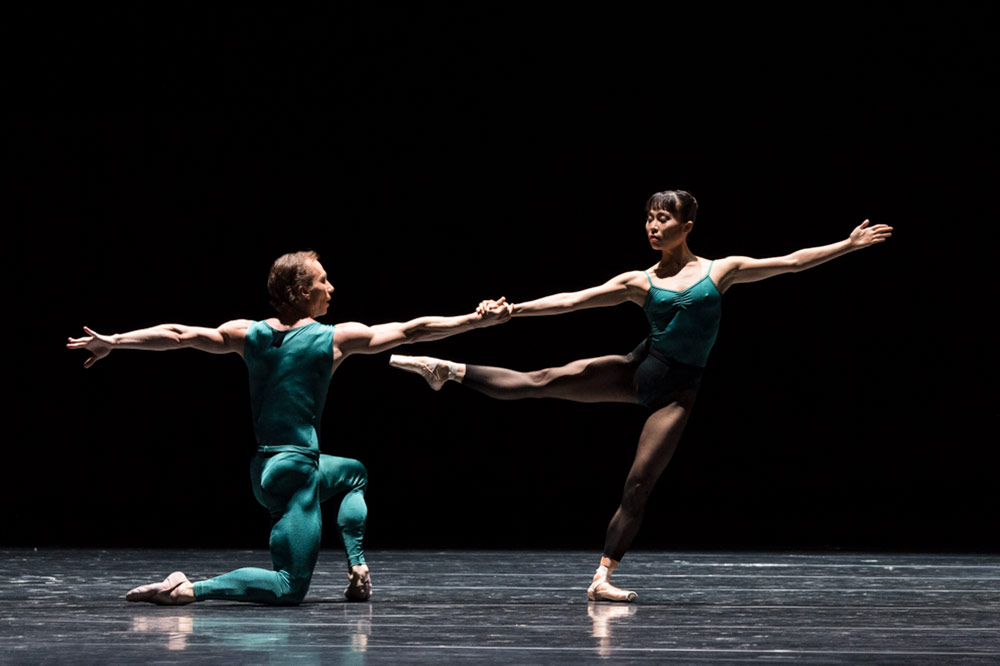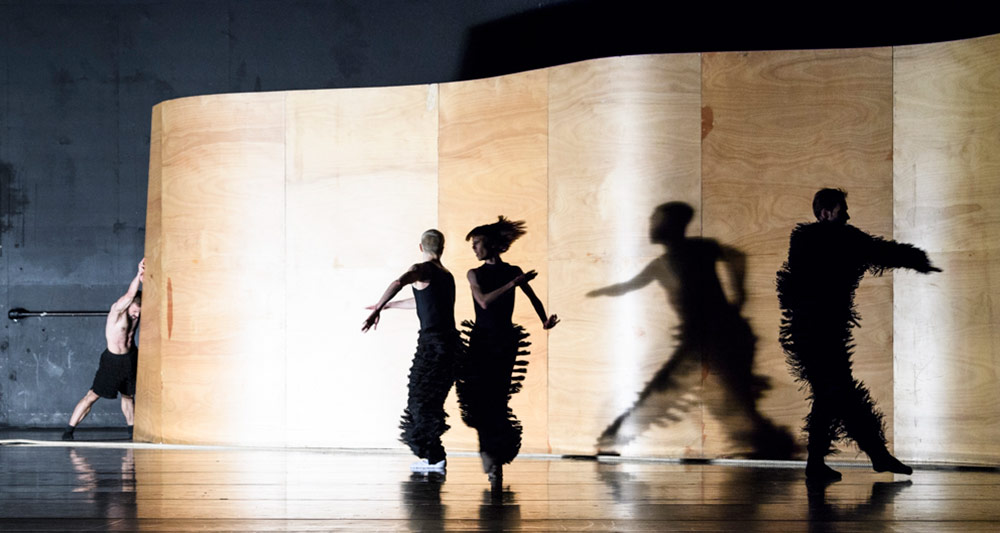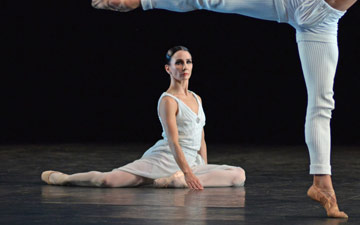
© Foteini Christofilopoulou. (Click image for larger version)
Semperoper Ballett
All Forsythe: In the Middle, Somewhat Elevated, Neue Suite, Enemy in the Figure
★★★✰✰
London, Sadler’s Wells
21 June 2018
Gallery of pictures by Foteini Christofilopoulou
www.semperoper.de
www.sadlerswells.com
Semperoper Ballett from Dresden prides itself on its wide repertoire of contemporary ballets – especially those by William Forsythe. Its Canadian artistic director, Aaron Watkin, was a member of Forsythe’s Frankfurt Ballet and has maintained a close relationship with the choreographer. Semperoper is the only company other than the Royal Ballet of Flanders to perform his three-act Impressing the Czar.

© Foteini Christofilopoulou. (Click image for larger version)
The first of the Forsythe ballets in the Sadler’s Wells triple bill is the centrepiece of Impressing the Czar, though it is often performed on its own. In the Middle, Somewhat Elevated was created in 1987 for the Paris Opera Ballet and featured a young Sylvie Guillem. (It’s now in English National Ballet’s repertoire.) A display case for nine dancers, it presents its cast as balletic athletes, stomping casually around the stage in between bouts of action – a ploy Wayne McGregor has appropriated.
The partnering, including a duet for two men, is combative. The participants yank each other around, the woman plunging into deep arabesques or being caught at arms’ length. Pointe shoes are weapons and skates for sliding. Men do most of the leaps, women the multiple pirouettes. While a pas de deux takes central stage, others continue performing or stand and watch, waiting to intervene. Thom Willems’s sound score chugs and crashes, building tension and excitement.

© Foteini Christofilopoulou. (Click image for larger version)
Semperoper’s dancers distort the classical ballet line more than the Paris Opera Ballet’s (or ENB’s) and don’t bother much with fifth positions or precise épaulement for Forsythe’s endless tendus. They seem contemporary dancers rather than étoiles being outrageous. Expectations of what ballet should be like have changed radically since the 1980s, thanks to Forsythe’s innovations.
His differing approaches towards the pas de deux are illustrated in the section called Neue Suite (New Suite), made of duets from his Frankfurt ballets in the 1990s. Eight couples in coloured practice clothes dance to music by three composers: Handel, Berio and Bach. The recordings were not well served by Sadler’s Wells’ notorious sound system.
The duets are about the music, not emotional relationships between the couples. The partnering is mostly egalitarian, without showy lifts or intimate intertwinings. Etiquette for the men changes according to the music: gallant for Handel, daring for Berio, courteously baroque for Bach’s Partita no.1. The skill is in the hand holds as the couples test each others’ weight and balance: they grip fists, wrists, forearms, challenging or supportive.
The Handel duets appear youthful, playful. The first, for Duosi Zhu and Gareth Haw in pink, is romantically close; the second, for Alice Mariani and Thomas Bieszka in green, lets the dancers separate to show off on their own, with Zarina Stahnke a soloist in the fourth until Houston Thomas joins in, jumping joyously and catching her as she falls into his arms.

© Foteini Christofilopoulou. (Click image for larger version)
The three Berio duets (from Forsythe’s workwithinwork) are more like feisty negotiations between potential mates. Jenny Laudadio and Jon Vallejo in blue are provocative and sensual, until they walk off dismissively in opposite directions; Aidan Gibson and Casey Ouzonis in red make insectoid shapes to eerie sounds, threatening each other.
The Bach duet, for very tall Sangeun Lee with Christian Bauch, resembles the central pas de deux in Balanchine’s Agon, where the man has to deal with her long limbs, even lying on his back. The impact is even odder to Bach than Stravinsky.
Oddest of all is the final piece, Enemy in the Figure, which became part of Forsythe’s Limb’s Theorem in 1989. By then, he was concerned with improvisational techniques and experiments with light, shadow and peripheral vision. (I remember worrying about an appointment with an optician after trying to watch Limb’s Theorem, when Frankfurt Ballet had regular seasons in Paris.) The result is exasperating or intriguing, poetic or absurd – or for some, a masterpiece.

© Foteini Christofilopoulou. (Click image for larger version)
The stage, stripped to the back wall, is partitioned by a curved plywood screen. A length of rope is flicked back and forth, further delineating the available performance space. A floodlight on wheels is trundled around by the performers, casting their shadows on the screen. Costumes start out as simple white or black leotards and become more elaborate as time passes, involving fringed outfits. Forsythe takes the credit for all the designs as well as the choreography, improvised or otherwise. Willems provided the chuntering score, a combination of industrial clunks, repetitive semi-melodies, wails and growls.
Trying to follow what is going on is like watching a company’s technical rehearsal, in which the lighting, scenery and performances have yet to be determined. Several different dance pieces might be being tried out simultaneously – a hornpipe in one corner, a group of cheerleaders or ballet students in another, a pas de deux partially out of sight behind the screen, a manic solo in front of it. In spite of an appreciative programme note extolling ‘a non-narrative of mystery and urgency, isolation and connection, the mechanical and the human’, I would rather have watched a polished performance with order rather than improvised chaos for 30 minutes. No discredit, though, to Semperoper’s dedicated dancers, scarcely visible and unidentifiable.

© Foteini Christofilopoulou. (Click image for larger version)
Forsythe was – still is – constantly looking for new ways of generating movement, experimenting with anatomical studies and relying on his dancers to come up with their own inventions. Many of his discoveries have been recycled by others – the fringed costumes, for example, that reappeared recently in Aszure Barton’s Fantastic Beings for ENB. Forsythe recently provided ENB with a new work, Playlist, in which he returned to his classical ballet beginnings to the delight of ENB’s audiences. He’ll be back at Sadler’s Wells in October, with a commission, A Quiet Evening of Dance, which is bound to be unpredictable.

















You must be logged in to post a comment.